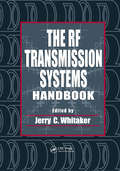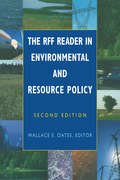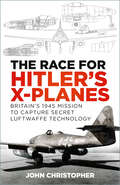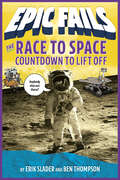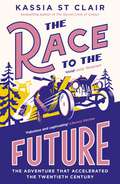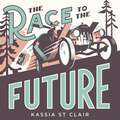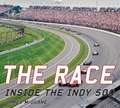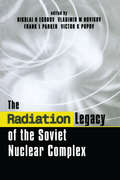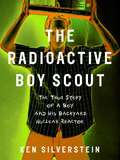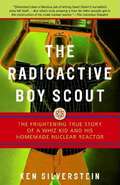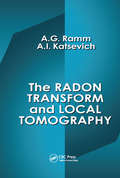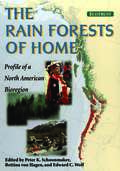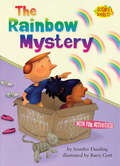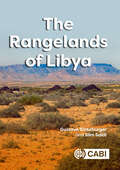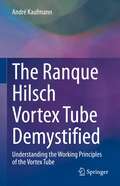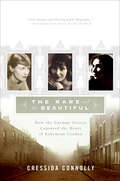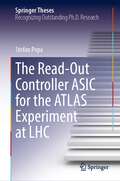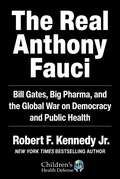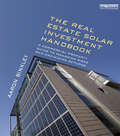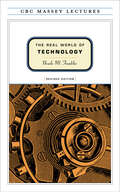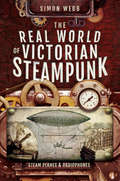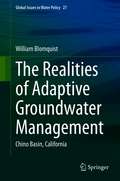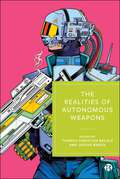- Table View
- List View
The RF Transmission Systems Handbook (Electronics Handbook Series #13)
by Jerry C. WhitakerAlthough it is one of the oldest sectors of electronics and now somewhat taken for granted, radio frequency transmission literally changed our world. Today, it is still the backbone of myriad applications, from broadcasting to electronic counter-measures. The wide variety of hardware in use means that those working in the field must be familiar with a multitude of principles and applications, but finding an up-to-date, comprehensive source for this background material has been difficult, if not impossible.The RF Transmission Systems Handbook addresses the underlying concepts, operation, and maintenance of high-power RF devices, transmission lines, and antennas for broadcast, scientific, and industrial use. Focusing on devices and systems that produce more than one kilowatt of output power, the handbook explores the following major topics:Applications: The common uses of radio frequency energyFundamental principles: The basic technologies, concepts, and techniques used in RF transmissionPower vacuum devices: The principles and applications of gridded vacuum tubes and microwave power devicesSolid-state power devices: The operating parameters of semiconductor-based power devicesRF components and transmission lines: The operation of hardware used to combine and conduct RF powerAntenna systems: The different types of antennas and their basic operating parametersTroubleshooting: Basic troubleshooting techniques and the operation of important test instrumentsContrary to the perceptions of many, RF technology remains a dynamic field that continues to advance to higher power levels and higher frequencies. Those who specify, install, and maintain RF equipment will welcome this reference that uniquely serves their needs.
The RFF Reader in Environmental and Resource Policy
by Wallace OatesMany articles in the Reader were originally published in RFF's quarterly magazine, Resources. Wally Oates has supplemented that with material drawn from other RFF works, including issue briefs and special reports. The readings provide concise, insightful background and perspectives on a broad range of environmental issues including benefit-cost analysis, environmental regulation, hazardous and toxic waste, environmental equity, and the environmental challenges in developing nations and transitional economies. Natural-resource topics include resource management, biodiversity, and sustainable agriculture. The articles address many of today's most difficult public policy questions, such as environmental policy and economic growth, and 'When is a Life Too Costly to Save?' New to the second edition is an expanded set of readings on global climate change and sustainability, plus cutting-edge policy applications on topics like the environment and public health and the growing problem of antibiotic and pesticide resistance. For general readers, the RFF Reader has been an accessible, nontechnical, authoritative introduction to key issues in environmental and natural resources policy. It has been especially effective in demonstrating the contribution that economics and other social science research can make toward improving public debate and decisionmaking. Organized to follow the contents of popular textbooks in environmental economics and politics, it has also found wide use in beginning environmental policy courses.
The Rabbit-Raising Problem Solver: Your Questions Answered about Housing, Feeding, Behavior, Health Care, Breeding, and Kindling
by Karen PatryWhile rabbits are well-known for being cute and fuzzy creatures, they can also be very difficult to care for. Whether you’re an experienced rabbit farmer or building your first hutch for a pet bunny, The Rabbit-Raising Problem Solver has answers to all of your most pressing questions. In a handy question-and-answer format Karen Patry expertly addresses every aspect of rabbit care, including housing, feeding, breeding, kindling, health, and behavior. This informative, easy-to-use guide has reliable, humane solutions that will keep your animals healthy and happy.
The Race for Hitler's X-Planes: Britain's 1945 Mission to Capture Secret Luftwaffe Technology
by John ChristopherDuring World War 2, Hitler’s engineers had pioneered an incredible array of futuristic secret weapons, from the Me 262, the first operational jet fighter, to the deadly V2 inter continental ballistic missile. With the Third Reich shattered and lying in ruins, in the summer of 1945, the Allies launched a frantic race to grab what they saw as the justifiable spoils of war. The Americans and Russians in particular were anxious to secure not only the aircraft and the research and production facilities, but also the key German scientists and engineers.This Nazi technology would define the balance of power in the phoney peace of the Cold War era, launching an arms race that shaped our modern world for decades to come. But what of Britain’s role in this supermarket sweep? The Race for Hitler’s X-Planes tells the untold story of the British mission to Germany.
The Race to Space: Countdown to Liftoff (Epic Fails #2)
by Ben Thompson Erik SladerIn this second installment of the Epic Fails series, explore the many failures that made up the Race to Space, paving the way for humanity’s eventual success at reaching the stars.Today, everyone is familiar with Neil Armstrong’s famous words as he first set foot on the moon: “one small step for man; one giant leap for mankind.” He made it look easy, but America’s journey to the moon was anything but simple. In 1957, when the Soviet Union launched Sputnik, the world’s first satellite, into orbit, America had barely crossed the starting line of the great Space Race. Later that year, our first attempt was such a failure that the media nicknamed it “Kaputnik.” Still, we didn’t give up. With each failure, we gleaned valuable information about what went wrong, and how to avoid it in the future. So we tried again. And again. And each time we failed, we failed a little bit better.The Epic Fails series by Erik Slader and Ben Thompson explores the humorous backstories behind a variety of historical discoveries, voyages, experiments, and innovations that didn't go as expected but succeeded nonetheless, showing that many of mankind's biggest success stories are the result of some pretty epic failures indeed.This title has Common Core connections.
The Race to the Future: The Adventure that Accelerated the Twentieth Century
by Kassia St Clair10 June 1907, Peking. Five cars set off in a desperate race across two continents on the verge of revolution.An Italian prince and his chauffeur, a French racing driver, a conman and various journalists battle over steep mountain ranges and across the arid vastness of the Gobi Desert. The contestants need teams of helpers to drag their primitive cars up narrow gorges, lift them over rough terrain and float them across rivers. Petrol is almost impossible to find, there are barely any roads, armed bandits and wolves lurk in the forests. Updates on their progress, sent by telegram, are eagerly devoured by millions in one of the first ever global news stories. Their destination: Paris. More than its many adventures, the Peking-to-Paris provided the impetus for profound change. The world of 1907 is poised between the old and the new: communist regimes will replace imperial ones in China and Russia; the telegraph is transforming modern communication and the car will soon displace the horse. In this book bestselling author Kassia St Clair traces the fascinating stories of two interlocking races - setting the derring-do (and sometimes cheating) of one of the world's first car races against the backdrop of a larger geopolitical and technological rush to the future, as the rivalry grows between countries and empires, building up to the cataclysmic event that changed everything - the First World War. The Race to the Future is the incredible true story of the quest against the odds that shaped the world we live in today.PRAISE FOR KASSIA ST CLAIR'Excellent, innovative and idiosyncratic history that will colour your thinking . . . St Clair writes with style, energy and knowledge' SPECTATOR'Hugely ambitious, sparklingly erudite and wonderfully engaging' PETER FRANKOPAN, HISTORY TODAY
The Race to the Future: The Adventure that Accelerated the Twentieth Century
by Kassia St ClairThe story of the world's most epic race you have never heard of.10 June 1907, Peking. Five cars set off in a desperate race across two continents on the verge of revolution.An Italian prince and his chauffeur, a French racing driver, a conman and various journalists battle over steep mountain ranges and across the arid vastness of the Gobi Desert. The contestants need teams of helpers to drag their primitive cars up narrow gorges, lift them over rough terrain and float them across rivers. Petrol is almost impossible to find, there are barely any roads, armed bandits and wolves lurk in the forests. Updates on their progress, sent by telegram, are eagerly devoured by millions in one of the first ever global news stories. Their destination: Paris. More than its many adventures, the Peking-to-Paris provided the impetus for profound change. The world of 1907 is poised between the old and the new: communist regimes will replace imperial ones in China and Russia; the telegraph is transforming modern communication and the car will soon displace the horse. In this book bestselling author Kassia St Clair traces the fascinating stories of two interlocking races - setting the derring-do (and sometimes cheating) of one of the world's first car races against the backdrop of a larger geopolitical and technological rush to the future, as the rivalry grows between countries and empires, building up to the cataclysmic event that changed everything - the First World War. The Race to the Future is the incredible true story of the quest against the odds that shaped the world we live in today.PRAISE FOR KASSIA ST CLAIR'Excellent, innovative and idiosyncratic history that will colour your thinking . . . St Clair writes with style, energy and knowledge' SPECTATOR'Hugely ambitious, sparklingly erudite and wonderfully engaging' PETER FRANKOPAN, HISTORY TODAY(P) 2023 Hodder & Stoughton Limited
The Race: Inside the Indy 500
by James McGuaneThe Race: Inside the Indy 500 examines in words and pictures this highly evolved auto-racing spectacle, which is hosting the 100th running in 2016. Author James McGuane has spent ten years working to capture the history of the Indy 500, which is loved my millions, and create a "top-to-bottom” and "start-to-finish” look at this heart-racing extravaganza.The author has used both camera and notepad to dive into the exclusive domain known as "Gasoline Alley.” McGuane addresses topics including the painstaking engineering of the cars; the high-stress training of the drivers; and the split-second actions of the race-car teams to keep the vehicles in meticulous condition. Indy’s past, present, and future are all revealed here.McGuane’s unrestricted access to racing greats, both past and present, offers a dazzling view of the racing life. He has developed and nurtured close contacts with senior Indy officials, drivers, and others connected to the race. Perfect for the avid motor-sports fan, this book includes interviews with many racing favorites, from Al Unser, Sr. to Parnelli Jones, Bobby Unser, and more.Skyhorse Publishing, as well as our Sports Publishing imprint, is proud to publish a broad range of books for readers interested in sports-books about baseball, pro football, college football, pro and college basketball, hockey, or soccer, we have a book about your sport or your team.In addition to books on popular team sports, we also publish books for a wide variety of athletes and sports enthusiasts, including books on running, cycling, horseback riding, swimming, tennis, martial arts, golf, camping, hiking, aviation, boating, and so much more. While not every title we publish becomes a New York Times bestseller or a national bestseller, we are committed to publishing books on subjects that are sometimes overlooked by other publishers and to authors whose work might not otherwise find a home.
The Radiation Legacy of the Soviet Nuclear Complex: An Analytical Overview
by Nikolai N. Egorov Vladimir M. Novikov Frank L. Parker Victor K. PopovA study of the legacy of nuclear contamination in the Soviet Union. It gives the location and characteristics of the accumulated radioactive material and wastes by each sector, from ore and mining to use and disposal. It describes types of storage, capacity and utilization, age and location. It gives information on the territories and locations contaminated, by normal operations and by accidents, from which strategic plans for remediation can be formulated.
The Radio Hobby, Private Associations, and the Challenge of Modernity in Germany (Palgrave Studies in the History of Science and Technology)
by Bruce B. CampbellIn the early twentieth century, the magic of radio was new, revolutionary, and poorly understood. A powerful symbol of modernity, radio was a site where individuals wrestled and came to terms with an often frightening wave of new mass technologies. Radio was the object of scientific investigation, but more importantly, it was the domain of tinkerers, “hackers,” citizen scientists, and hobbyists. This book shows how this wild and mysterious technology was appropriated by ordinary individuals in Germany in the first half of the twentieth century as a leisure activity. Clubs and hobby organizations became the locus of this process, providing many of the social structures within which individuals could come to grips with radio, apart from any media institution or government framework. In so doing, this book uncovers the vital but often overlooked social context in which technological revolutions unfold.
The Radioactive Boy Scout
by Ken SilversteinGrowing up in suburban Detroit, David Hahn was fascinated by science. While he was working on his Atomic Energy badge for the Boy Scouts, David's obsessive attention turned to nuclear energy. Throwing caution to the wind, he plunged into a new project: building a model nuclear reactor in his backyard garden shed. Posing as a physics professor, David solicited information on reactor design from the U. S. government and from industry experts. Following blueprints he found in an outdated physics textbook, David cobbled together a crude device that threw off toxic levels of radiation. His wholly unsupervised project finally sparked an environmental emergency that put his town's forty thousand suburbanites at risk. The EPA ended up burying his lab at a radioactive dumpsite in Utah. This offbeat account of ambition and, ultimately, hubris has the narrative energy of a first-rate thriller.
The Radioactive Boy Scout: The Frightening True Story of a Whiz Kid and His Homemade Nuclear Reactor
by Ken SilversteinThrowing caution to the wind, David Hahn plunged into a new project: building a model nuclear reactor in his backyard garden shed. Posing as a physics professor, David solicited information on reactor design from the U.S. government and from industry experts. Following blueprints he found in an outdated physics textbook, David cobbled together a crude device that threw off toxic levels of radiation. His wholly unsupervised project finally sparked an environmental emergency that put his town's forty thousand suburbanites at risk. The EPA ended up burying his lab at a radioactive dump site in Utah. This offbeat account of ambition and, ultimately, hubris has the narrative energy of a first-rate thriller.
The Radon Transform and Local Tomography
by Alexander G. Ramm Alex I. KatsevichOver the past decade, the field of image processing has made tremendous advances. One type of image processing that is currently of particular interest is "tomographic imaging," a technique for computing the density function of a body, or discontinuity surfaces of this function. Today, tomography is widely used, and has applications in such fields as medicine, engineering, physics, geophysics, and security. The Radon Transform and Local Tomography clearly explains the theoretical, computational, and practical aspects of applied tomography. It includes sufficient background information to make it essentially self-contained for most readers.
The Rain Forests of Home: Profile Of A North American Bioregion
by Jerry F. Franklin Patricia Marchak Peter Schoonmaker Edward C. Wolf Bettina Von HagenStretching from the redwoods of California to the vast stands of spruce and hemlock in southeast Alaska, coastal temperate rain forests have been home to one of the highest densities of human settlements on the continent for thousands of years. However, the well-being of this region is increasingly threatened by diminishing natural capital, declining employment in traditional resource-based industries, and outward migration of young people to cities.The Rain Forests of Home brings together a diverse array of thinkers -- conservationists, community organizers, botanists, anthropologists, zoologists, Native Americans, ecologists, and others -- to present a multilayered, multidimensional portrait of the coastal temperate rain forest and its people. Joining natural and social science perspectives, the book provides readers with a valuable understanding of the region's natural and human history, along with a vision of its future and strategies for realizing that vision.Authors describe the physical setting and examine the geographic and evolutionary forces that have shaped the region since the last glacial period, with individual chapters covering oceanography, climate, geologic processes, vegetation, fauna, streams and rivers, and terrestrial/marine interactions. Three chapters cover the history of human habitation, and the book concludes with an exploration of recent economic, political, and cultural trends.Interspersed among the chapters are compelling profiles of community-level initiatives and programs aimed at restoring damaged ecosystems, promoting sustainable use of resources, and fostering community-based economic development. The Rain Forests of Home offers for the first time a unified description of the characteristics, history, culture, economy, and ecology of the coastal temperate rain forest. It is essential reading for anyone who lives in or cares about the region.
The Rainbow Mystery (Science Solves It!)
by Jennifer DusslingSolve kid-sized dilemmas and mysteries with the Science Solves It! series. These fun books for kids ages 5–8 blend clever stories with real-life science. Why did the dog turn green? Can you control a hiccup? Is that a UFO? Find the answers to these questions and more as kid characters dive into physical, life, and earth sciences. Colors on the loose! Annie and Mike are making a box fort when a bunch of little rainbows mysteriously appear on the family room wall. Are they from a sprinkler? A gas puddle? A necklace? Annie and Mike need scientific detective skills to solve this rainbow mystery! Books in this perfect STEM series will help kids think like scientists and get ahead in the classroom. Activities and experiments are included in every book! (Level Two; Science topic: Rainbows)
The Rangelands of Libya
by Gustave Gintzburger Slim SaïdiLibya remains a land of mysteries with a harsh arid climate, a land rich in millenaries of troubled history, a land where the Sahara meet the Mediterranean Sea, a land where the West and the East Mediterranean merge. Libya is also a land where the desert and the sown intermingle in the steppe country where the rainfall is unpredictable, the soils are poor, rocky, saline, rendering rainfed cultivation hazardous, where grazing and rainfed cropping remained for long the only viable agricultural options. Over the past 60 years, oil resources allowed gigantic agricultural development projects, urbanization, road network expansion and well drilling. This changed the ways of life of rural populations, impacting and undoubtedly altering rangelands conditions and systems, as well as native vegetation cover, wildlife and land use. This book reviews the past and current environmental and agricultural condition of the Libyan rangelands with example of how territories and resources are used by tribal communities. It describes, explains and illustrates the landscapes, the vegetation, the wildlife, the rainfed cereal systems and livestock systems, the reasons for the rampant overstocking, the relentless land clearing for hazardous cropping and uncertain irrigation projects, the wild fuelwood collection and charcoal manufacturing, triggering land degradation and desertification. Long-tested rangeland recovery and rehabilitation techniques in Libya are reviewed using appropriate plant material and proven establishment techniques with successes and failures assessed. This book is offered in hopes of a better future for the Libyan people and the whole Mediterranean arid regions from Morocco to Pakistan.
The Ranque Hilsch Vortex Tube Demystified: Understanding the Working Principles of the Vortex Tube
by André KaufmannThe book describes the thermodynamics, fluid dynamics, and working principle of the Ranque Hilsch Vortex Tube. Although vortex tubes have been around for a long time, different explications of their fundamental physics and operation can be found in literature and on the internet. This volume investigates the working principle based on thermodynamics and fluid dynamics. It provides full explication of these parameters in one single work along with results of new investigations not published elsewhere. In addition, the book features a wealth of illustrations on various aspects of the vortex tube that make it easy to read and understand.
The Rare and the Beautiful: How the Garman Sisters Captured the Heart of Bohemian London
by Cressida ConnollyLike the better-known Mitfords, the Garman sisters took center stage in Bohemian London during the first half of the twentieth century. Beautiful, flamboyant, and headstrong, they broke away from middle-class conventions, seducing and inspiring a generation of artists. Kathleen, an enigmatic artist's model and aspiring pianist, was the lover and, later, wife of controversial American-born sculptor Jacob Epstein. Mary married the maverick poet Roy Campbell, whose verse attack on the Bloomsbury group following Mary's affair with Vita Sackville-West was the literary scandal of the epoch. Lorna, the youngest and most beautiful of the sisters, was the lover of both the painter Lucian Freud and the poet Laurie Lee.The Rare and the Beautiful offers the first portrait of a beguiling band of eccentric siblings who possessed an uncanny ability to turn heads, break hearts, and spark creative genius. Set against the exciting backdrop of London's decadent subculture, it evokes their extraordinary milieu of high culture, drama, and scandal.
The Read-Out Controller ASIC for the ATLAS Experiment at LHC (Springer Theses)
by Stefan PopaThis thesis presents the complete chain from specifications to real-life deployment of the Read Out Controller (ROC) ASIC for the ATLAS Experiment at LHC, including the design of the FPGA-based setup used for prototype validation and mass testing of the approximately 6000 chips. Long-lasting experiments like the ATLAS at the LHC undergo regular upgrades to improve their performance over time. One of such upgrades of the ATLAS was the replacement of a fraction of muon detectors in the forward rapidities to provide much-improved reconstruction precision and discrimination from background protons. This new instrumentation (New Small Wheel) is equipped with custom-designed, radiation-hard, on-detector electronics with the Read Out Controller chip being a mission-critical element. The chip acts as a clock and control signals distributor and a concentrator, buffer, filter and real-time processor of detector data packets. The described and deployed FPGA-based test setup emulates the asynchronous chip context and employs optimizations and automatic clock and data synchronization. The chip's tolerance to nuclear radiation was evaluated by recording its operation while controlled ultrafast neutron beams were incident to its silicon die. Predictions for the operating environment are made. A proposed implementation of an FPGA Integrated Logic Analyzer that mitigates the observed limitations and constraints of the existing ones is included.
The Real Anthony Fauci: Bill Gates, Big Pharma, and the Global War on Democracy and Public Health (Children’s Health Defense)
by Robert F. Kennedy Jr.#1 on AMAZON, TWENTY WEEKS on the NEW YORK TIMES BESTSELLER LIST, and a WALL STREET JOURNAL, USA TODAY and PUBLISHERS WEEKLY NATIONAL BESTSELLEROver 1,000,000 copies sold despite censorship, boycotts from bookstores and libraries, and hit pieces against the author. Pharma-funded mainstream media has convinced millions of Americans that Dr. Anthony Fauci is a hero. Hands down, he is anything but. As director of the National Institute of Allergy and Infectious Diseases (NIAID), Dr. Anthony Fauci dispenses $6.1 billion in annual taxpayer-provided funding for rigged scientific research, allowing him to dictate the subject, content, and outcome of scientific health research across the globe—truly a dark agenda. Fauci uses the financial clout at his disposal in a back handed manner to wield extraordinary influence over hospitals, universities, journals, and thousands of influential doctors and scientists—whose careers and institutions he has the power to ruin, advance, or reward in an authoritarian manner. During more than a year of painstaking and meticulous research on his laptop and through interviews, Robert F. Kennedy Jr. unearthed a shocking story that obliterates media spin on Dr. Fauci . . . and that will alarm every American—Democrat or Republican—who cares about democracy, our Constitution, and the future of our children&’s health.The Real Anthony Fauci reveals how &“America&’s Doctor&” launched his career during the early AIDS crisis by partnering with pharmaceutical companies to sabotage safe and effective off-patent therapeutic treatments for AIDS. Fauci orchestrated fraudulent do-nothing studies, and then pressured US Food and Drug Administration (FDA) regulators into approving a deadly chemotherapy treatment he had good reason to know was worthless against AIDS. Fauci did the unthinkable and repeatedly violated federal laws to allow his Pharma partners to use impoverished and dark-skinned children as lab rats in beyond order, deadly experiments with toxic AIDS and cancer chemotherapies. In early 2000, Fauci shook hands with Bill Gates in the library of Gates&’ $147 million Seattle mansion, cementing a partnership that would aim to control an increasingly profitable $60 billion global vaccine enterprise with unlimited growth potential. Through funding leverage and carefully cultivated personal relationships with heads of state and leading media and social media institutions, the Pharma-Fauci-Gates alliance exercises dominion over global health policy and our beautiful country. This is not just another political book. The Real Anthony Fauci details how Fauci, Gates, and their cohorts use their control of media outlets—both conservative and liberal leaning, scientific journals, key government and quasi-governmental agencies, global intelligence agencies, and influential scientists and physicians to flood the public with fearful propaganda about COVID-19 virulence and pathogenesis, and to muzzle debate and ruthlessly censor dissent.
The Real Estate Solar Investment Handbook: A Commercial Property Guide to Managing Risks and Maximizing Returns
by Aaron BinkleyThe Real Estate Solar Investment Handbook explains the business case for property professionals to pursue solar projects. A project’s value is determined by its potential risks and rewards; these are explained thoroughly in terms understood by the real estate industry. This book provides a framework for practical decision-making, with each chapter addressing a step in the process, from project idea to completion. Written from the perspective of the commercial real estate industry professional, it will help investors evaluate opportunities and execute projects that offer solid risk-adjusted investments. For property owners, investors, landlords, service providers, and all those looking to invest in solar on commercial property, The Real Estate Solar Investment Handbook will guide you through all the steps needed to gain years of revenue from a project.
The Real World of Technology (The CBC Massey Lectures)
by Ursula FranklinIn this expanded edition of her bestselling 1989 CBC Massey Lectures, renowned scientist and humanitarian Ursula M. Franklin examines the impact of technology upon our lives and addresses the extraordinary changes since The Real World of Technology was first published. In four new chapters, Franklin tackles contentious issues, such as the dilution of privacy and intellectual property rights, the impact of the current technology on government and governance, the shift from consumer capitalism to investment capitalism, and the influence of the Internet upon the craft of writing.
The Real World of Victorian Steampunk: Steam Planes & Radiophones
by Simon WebbA look at the surprising nineteenth-century technology that inspires this literary and cultural movement: &“I was very impressed by this book.&” —SF Crowsnest In recent decades, steampunk has grown from a rather obscure subgenre of science fiction into a striking and distinctive style of fashion, art, design, and even music. It is in the written word, however, that steampunk has its roots—and in this book Simon Webb explores and examines the real inventions that underpin the fantasy. In doing so, he reveals a world unknown to most people today. Webb reveals the Victorian era as a surprising place: one of steam-powered airplanes, fax machines linking Moscow and St Petersburg, steam cars traveling at over 100 mph, electric taxis, and wireless telephones. It is, in short, the nineteenth century as you&’ve never before seen it—a steampunk extravaganza of anachronistic technology and unfamiliar gadgets. Imagine Europe spanned by a mechanical internet, a telecommunication system of clattering semaphore towers capable of transmitting information across the continent in a matter of minutes. Consider too, the fact that a steam plane the size of a modern airliner took off in England in 1894. Drawing entirely on contemporary sources, we see how little-known developments in technology have been used as the basis for so many steampunk narratives. From seminal novels such as The Difference Engine to the steampunk fantasy of Terry Pratchett&’s later works, this book shows that steampunk is at least as much solid fact as it is whimsical fiction.
The Realities of Adaptive Groundwater Management: Chino Basin, California (Global Issues in Water Policy #27)
by William BlomquistThis book has three primary objectives. The first objective is to provide scholars with a more realistic view of adaptive management, without arguing against adaptive management. Adaptive management is necessary as well as desirable, but it is not easy, and demonstrating that through the Chino Basin experience is an important goal. The second objective is to provide practitioners with encouraging yet cautionary lessons about the challenges and benefits of an adaptive approach – in similar fashion as the first objective, the goal here is to endorse the adaptive approach but in a clear-eyed manner that clarifies how hard it is and how much it requires. A third objective is to show all audiences that resource governance systems can fail, change, and succeed. There is no such thing as an ideal institutional design that is guaranteed to work; rather, making institutional arrangements work entails learning and adjustment when they begin to show problems as they inevitably will.
The Realities of Autonomous Weapons
by Thomas Christian Bächle and Jascha BareisAvailable open access digitally under CC-BY-NC-ND licence. The realities of autonomous weapons are a complex blend of both existing military technologies and visions of their future capabilities. The expected ramifications are profound and always point to the interplay between fact and fiction, actual developments and creative imagination. This book explores how these realities shape and become themselves shaped by popular culture, regulatory and ethics debates, military doctrines, policies and research. It examines phenomena ranging from film and artistic interpretations to warfare scenarios and weaponized artificial intelligence. Intended for researchers (including the disciplines of political and social sciences, media, culture and technology), policy makers, educators and journalists, this is a key resource that uncovers how autonomous weapons are constructed as both a technological reality and a futuristic possibility.
